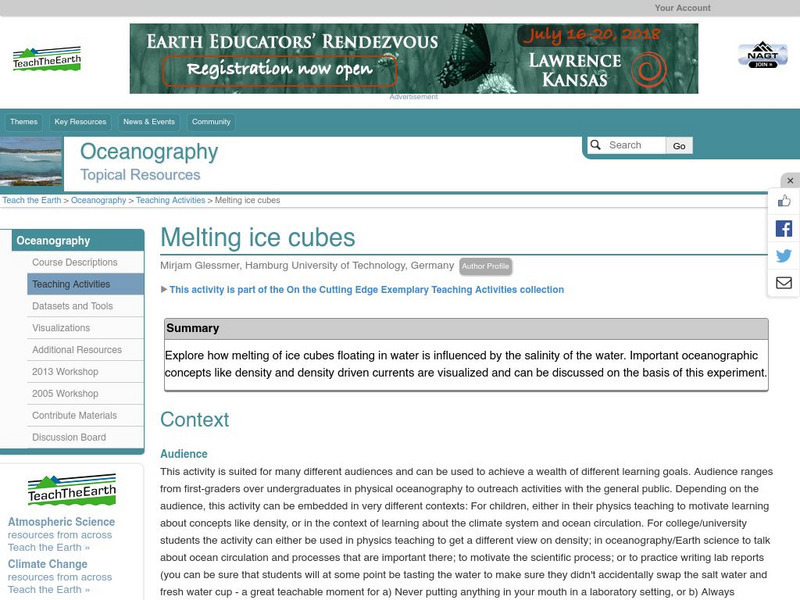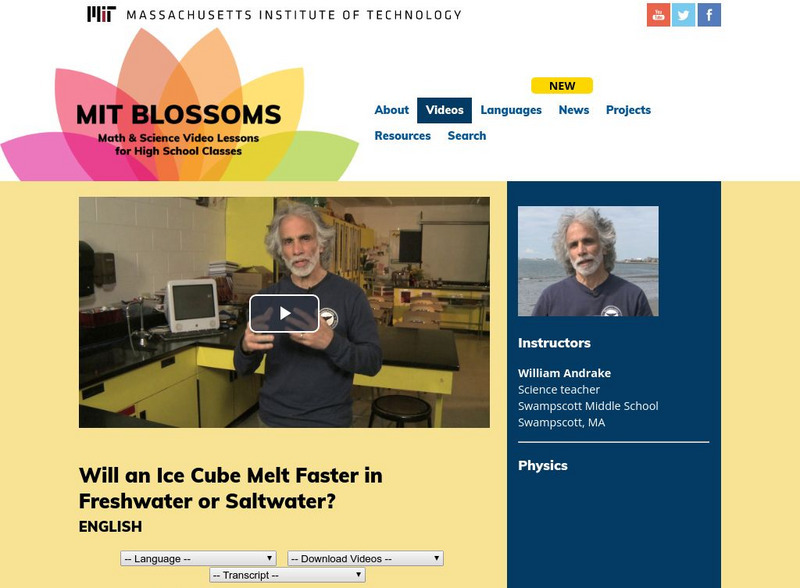Science Education Resource Center at Carleton College
Serc: Melting Ice Cubes
This activity helps students understand how the melting of ice cubes floating in water is influenced by the salinity of the water. It will introduce the concept of density and density driven currents and provide practice in using the...
Massachusetts Institute of Technology
Mit: Blossoms: Will an Ice Cube Melt Faster in Freshwater or Saltwater?
Engage learners in the study of the ocean and saltwater with these activities. Students will see that saltwater has different physical properties than freshwater - mainly density. This lesson can serve as a springboard into other...
Other
American Society for Engineering Education: E Gfi: Activity: Keep a Cube
In this activity, student teams in grades K-6 explore the design process by engineering a way to keep an ice cube from melting for 30 minutes. [6:00]
PBS
Pbs Learning Media: Melting and Boiling Simulation
Observe the motion and temperature of water molecules in this simulation as heat is applied to a beaker containing an ice cube.
PBS
Pbs Teachers: Rising Ice Experiment
Observe how ice and salt crystals interact by using salt to help adhere a string to the top of an ice cube in a glass of water, then lift the cube out of the water.
Science Education Resource Center at Carleton College
Serc: Mn Step: Will the Cup of Water Overflow When the Ice Melts?
Learners predict and observe what happens when the ice cubes in a cup of water melt and displace water.
TeachEngineering
Teach Engineering: Do Different Colors Absorb Heat Better?
Students test whether the color of a material affects how much heat it absorbs. Students will place an ice cube in a box made of colored paper (one box per color; white, yellow, red and black), which they will place in the sun. The...
TOPS Learning Systems
Tops Learning Systems: Top Science: Slow Drips [Pdf]
Investigate density by floating an ice cube on the surface of cooking oil and observe what happens as it melts.
TeachEngineering
Teach Engineering: Insulation Materials Investigation
Students test the insulation properties of different materials by timing how long it takes ice cubes to melt in the presence of various insulating materials. Students learn about the role that thermal insulation materials can play in...
TeachEngineering
Teach Engineering: Engineering for the Earth
Young students are introduced to the complex systems of the Earth through numerous lessons on its natural resources, processes, weather, climate and landforms. Key earth science topics include rocks, soils and minerals, water and natural...
Better Lesson
Better Lesson: A Place in the Shade an Engineering Challenge
Kindergarteners can participate in the engineering and design process in this challenge in which they try to keep an ice cube from melting. Included in this lesson plan are samples of student's structures, a video of a kindergarten class...
Science Education Resource Center at Carleton College
Serc: Heat Transfer Heat Absorption
Learners will be given a chance to place their hands on two different objects and then predict on which an ice cube will melt more quickly. Students will make a prediction as to what will happen when balloons filled with air and with...












